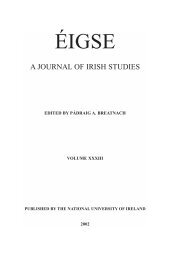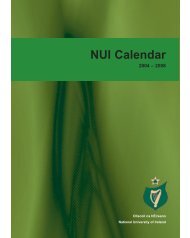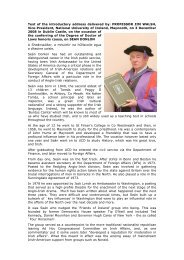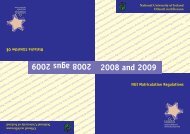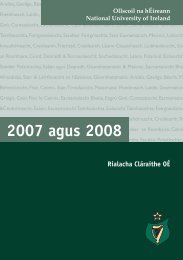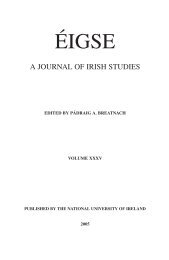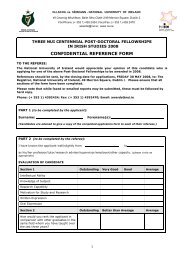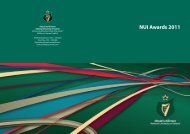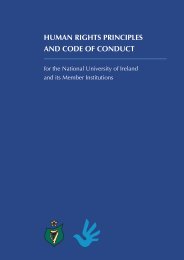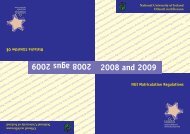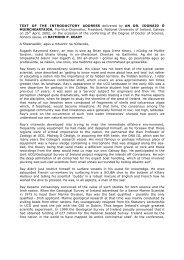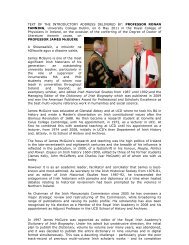Eigse Paged 2004 - National University of Ireland
Eigse Paged 2004 - National University of Ireland
Eigse Paged 2004 - National University of Ireland
You also want an ePaper? Increase the reach of your titles
YUMPU automatically turns print PDFs into web optimized ePapers that Google loves.
SETTLEMENT IN MEDIEVAL IRELAND 43<br />
example, Duffy shows that the vast majority <strong>of</strong> ballybetaghs comprise<br />
sixteen tates. 105 This is echoed in Keating’s description <strong>of</strong><br />
twelve, or exceptionally fourteen, seisreacha to the baile bíataigh.<br />
Although this schema is certainly excessively prescriptive for<br />
Keating’s own time, it probably illustrates reasonably accurately the<br />
basic principle <strong>of</strong> the system as it once existed. McErlean is<br />
undoubtedly correct in seeing in the ballybetaghs and similar units<br />
the structure within which the Gaelic taxation system operated. 106<br />
The packaging <strong>of</strong> equal numbers <strong>of</strong> medium-sized land units <strong>of</strong><br />
equivalent economic capacity (tates in Monaghan, for example) into<br />
large units (ballybetaghs) is a simple and elegant solution for ensuring<br />
the easy administration <strong>of</strong> the assessment <strong>of</strong> taxes and dues. It<br />
also had repercussions for the system <strong>of</strong> landholding. As Duffy<br />
demonstrates, the ballybetagh and its subdivisions were also a device<br />
for the lord to allocate his lands among branches <strong>of</strong> client septs or<br />
followers, although this must be seen as secondary to the primary<br />
function <strong>of</strong> these divisions in tax evaluation. 107<br />
The various applications <strong>of</strong> the term baile appear bewildering,<br />
even contradictory, at times. It is a homestead and a farm; a village<br />
and a city; a house cluster and a ballybetagh. However, these apparently<br />
disparate entities share common features that are expressed in<br />
this single term. The defining characteristic <strong>of</strong> the baile is occupied<br />
space, whether by a habitation (farmstead, village, town, etc.) or by<br />
agricultural land (farm, townland, ballybetagh). Each place is important<br />
by virtue <strong>of</strong> the presence <strong>of</strong> people who imbue it with an economic<br />
and social function in relation to the provision <strong>of</strong> food and<br />
raising <strong>of</strong> revenue. The town facilitates trade and commerce and<br />
pays taxes. The farm sustains its inhabitants and produces a surplus<br />
so that tax can be paid to the king and food-rent to the lord. It is part<br />
<strong>of</strong> a larger tax-assessment unit (the forerunner <strong>of</strong> the modern townland),<br />
which in turn is part <strong>of</strong> a larger unit <strong>of</strong> assessment (ballybetagh).<br />
The baile, therefore, is fundamentally concerned with the<br />
organisation <strong>of</strong> people, land and resources for the sustenance <strong>of</strong> the<br />
inhabitants and the generation <strong>of</strong> material goods.<br />
<strong>University</strong> <strong>of</strong> Ulster at Coleraine<br />
GREGORY TONER<br />
105<br />
Patrick J. Duffy, ‘Social and spatial order in the Mac Mahon lordship <strong>of</strong> Airghialla<br />
in the late sixteenth century’ in Duffy et al., Gaelic <strong>Ireland</strong> 115-37 (at pp 126-9).<br />
106<br />
McErlean, ‘The Irish townland system’ 326-8.<br />
107<br />
Duffy, ‘Social and spatial order’ 130.



